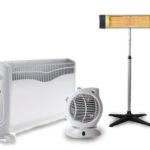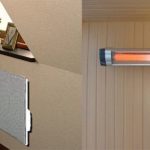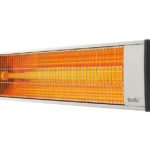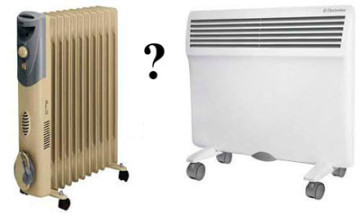Which is better, quartz or infrared heater?
 The onset of cold weather forces many residents to think about additional heating of their homes - one of the options is a heater. When visiting a store, there is often a situation where a person does not know what is best, because today there are quartz, infrared and other heaters on the market. The wide variety of models is not easy for a specialist to understand, let alone for an ordinary buyer.
The onset of cold weather forces many residents to think about additional heating of their homes - one of the options is a heater. When visiting a store, there is often a situation where a person does not know what is best, because today there are quartz, infrared and other heaters on the market. The wide variety of models is not easy for a specialist to understand, let alone for an ordinary buyer.
The content of the article
Pros and cons of quartz heaters
These devices heat the air using a nichrome heating element. To increase heat transfer and minimize harmful effects on the environment, quartz sand is used. The reflector is a metal plate that is located behind the heater - when infrared rays are reflected, a directional effect is formed.
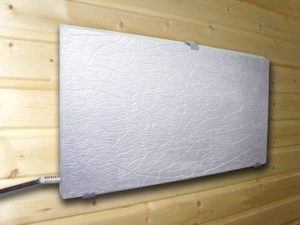 Monolithic quartz heaters are similar in appearance to the heating radiators familiar to everyone: inside such a device there is a heater, which is placed in pressed sand. This design allows the heater to be completely isolated from environmental influences, which significantly extends its service life.
Monolithic quartz heaters are similar in appearance to the heating radiators familiar to everyone: inside such a device there is a heater, which is placed in pressed sand. This design allows the heater to be completely isolated from environmental influences, which significantly extends its service life.
Pros:
- High energy efficiency - this heating method allows you to significantly save energy;
- Safety - the lamps do not contain harmful impurities (mercury and liquid metal), so they can be disposed of as regular waste;
- Heaters of this type can be used in industrial facilities when quick drying of various surfaces or things, drying of vegetables, etc. is required;
- Instant heating of the room;
- A special flask for the heater eliminates the burning of oxygen;
- Long service life and high reliability;
Minuses:
- Relatively high mass (for quartz monolithic systems);
- High heating of the surfaces of the device during operation at full power - careless use of the device can lead to burns.
- The cost of these devices is quite high.
Advantages and disadvantages of infrared heaters
Unlike convectors, these devices heat objects in the room, as well as walls and floors, without heating the air at all. Infrared radiation is similar to the sun's rays - it also gives a feeling of warmth, but is not visible to the human eye.
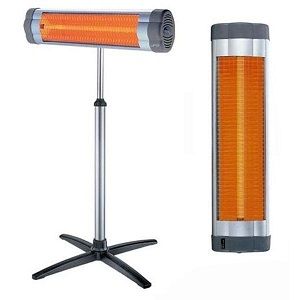 Important! Unlike convectors, infrared heating devices can immediately give a feeling of warmth after it starts working, and it can not be felt throughout the entire room, but only in the place where the device is located.
Important! Unlike convectors, infrared heating devices can immediately give a feeling of warmth after it starts working, and it can not be felt throughout the entire room, but only in the place where the device is located.
The design of the device does not contain any complex parts: a steel body coated with durable paint has an aluminum reflector on which a heating element (halogen, carbon, ceramic or tubular) is located.
The device also contains a thermostat, with which you can regulate the temperature and a sensor that turns off the device when the specified temperature is reached.If the heater has a floor-mounted design, it is additionally equipped with a tip-over sensor.
Pros:
- All surfaces that are exposed to infrared radiation begin to warm up and give off heat, heating the air;
- Uniform heating over the entire area;
- Silent operation and high environmental friendliness;
- Long service life and high reliability.
Minuses:
- When using the device for a long time, a person may experience discomfort;
- Quite a lot of power consumption;
- When home furnishings heat up, they wear out faster.
Which is better, quartz or infrared heater?
Before choosing a device, you must first decide on the following:
- What area is planned to be heated - the size of the room directly affects the required power. For example, in small rooms it is best to install a convector.
- What role will be assigned to the device: the only or additional heating source. Quartz heaters or convectors are best suited as additional heating means, while infrared heaters can become the main source of heat.
- The degree of safety required from the device. The device may have a built-in thermostat that will automatically turn off the device when it reaches the required temperature. Today, all types of heaters are equipped with thermostats.
Let's look at all types of devices in more detail, all the parameters, to determine which heater is better.
Heating duration
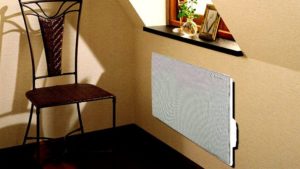
Infrared devices, unlike other types, are able to instantly heat objects, while quartz heating devices gradually heat the air and objects in the room.
Cost-effective and environmentally friendly
Each type has a high degree of environmental safety and high efficiency, but infrared heaters consume a fairly large amount of electricity.
Comfort and safety
Heating devices with quartz heaters have a high level of fire safety; a person does not experience any comfort during their operation. Infrared heaters are quite fire hazardous, since their operation can ignite objects, as well as dust on the glass bulb of the lamp.
Important! When using IR lamps for a long time, a person may experience a deterioration in their health.
Lifetime
Quartz heaters have a clear superiority in service life compared to other types. IR heating devices have significantly less strength, which gives them a high risk of premature failure.

